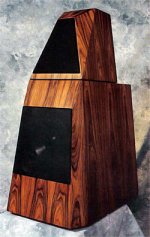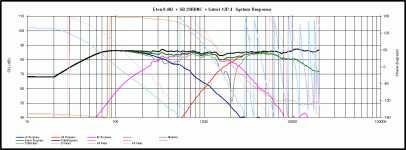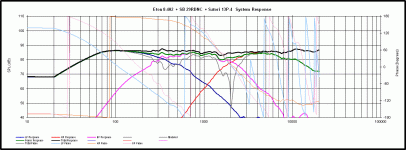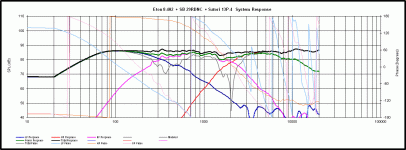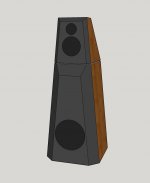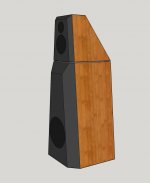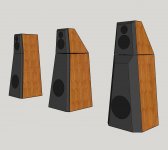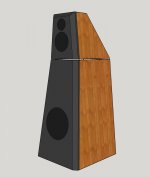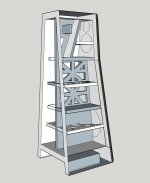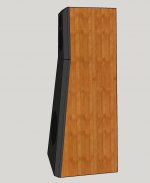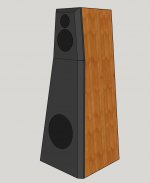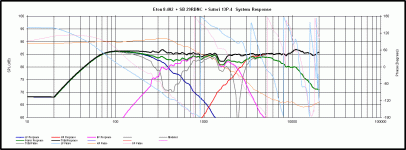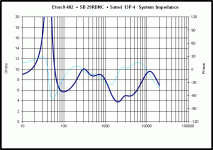You are aware that these are open back speakers and the issues this causes such as where they need be sited in the room and how the sound is different from "standard". There are good reasons almost no commercial speakers are like this.
Most commercial offerings the average joe buys normally does not heed the placement advice given, or never read instructions or doesn't fit into the scheme of things (astetics, WAF, etc.). No different in additude than most think a speaker is nothing more than a couple three speakers stuck on a box simple. Hook up wires and enjoy.
Ignorance is bliss.
1" of alignment between a bass and mid is nonsense, and easily accounted for in the acoustic responses by slight assymetry.
3 points here:
1. Nonsense it's nonsense.
2. What makes you think that I'm not already modelling with asymmetric slopes? I've got 2nd order electrical on both the mid and the woofer but with 2nd order acoustic on the woofer and 3rd order acoustic on the mid. Bumping 1 or both of the drivers up to 3rd order electrical misaligns the phase even more. Some resistance on the parallel leg helps things out but then the acoustic slope is greatly reduced, raising the cone breakup of the woofer to higher levels. Not acceptable for this design. So I'm just looking for a small bit of help via the physical alignment. Charts 1, 2 and 3 below show the response with the drivers 1st on a flat baffle, then with the mid 1.5" back from the woofer and lastly 1.5" back with some extra resistance added in the parallel leg. I'm liking the 2nd one best. Any small detail I can use to improve the design here I will.
3. My analysis at this point is a little premature because I've hit a small snag modeling the Eton-8. Normally for simulations, I rely on the manufacturer's driver diagram to estimate the driver's acoustic center but with the Etons, the diagrams are actually not proportioned correctly so I can't blow them up to actual size and do the physical measurement. I'm going to have to wait until artofwar has them in hand to get him to make the measurements. (And yes, I know acoustic measurements are the way the accurately do this, but that's not what we're working with here right now).
Arguably the best approach to a mid/treble cabinet is a floating cabinet within a cabinet, a dual layer.
Yes, no disagreement here, but I also don't see much consensus on how to implement it. What do you recommend as the middle, flexible layer and how thick? Should it be used on the bottom as well? Should the baffle contact only the 'inside' cabinet? Is bracing required and if so, do you brace the inside cab or the outside one?
Something that I was going to recommend for high end drivers to improve the stiffness and deadness of the baffles is to use threaded rods, front to back, to affix the baffles. Crank 'em tight and they're not resonating. But I can't figure out how to do that and use the floating cab inside a cab concept without having the baffle contact the outer cabinet and transfer any of its mechanical vibrations to the outside cab instead of to the inside one.
BSC cannot be ignored realistically, it will apply to the mid.
I'm not sure where this is coming from. I find bsc for the mid isn't really required for the mid in a 3-way when you cross mid to woofer somewhere around the mids' baffle step loss -3dB point or above which is what I'm doing in this instance.
Attachments
I wasn't thinking of the average joe's speaker so much as standard high performance speakers like studio monitors and the more technical performance orientated home audio speakers. Despearce is building his first speaker and it was not clear that he understood he was opting for an abnormal speaker and that because of the rear radiation it would both sound different and not perform well when placed where most people seem to end placing their speakers. No problems if he knows this and is happy with it but it is something of weird suggestion for a first speaker.Most commercial offerings the average joe buys normally does not heed the placement advice given, or never read instructions or doesn't fit into the scheme of things (astetics, WAF, etc.). No different in additude than most think a speaker is nothing more than a couple three speakers stuck on a box simple. Hook up wires and enjoy.
Ignorance is bliss.
I understand the need for space behind the speaker or some kind of trap, I'm wanting to build my own speakers and this looks like a simple project in many ways. I have experience in assembling pcbs and point to point valve wiring so the crossover should be easily doable.
I like the look of Pi corner horns but might not quite have the room for them, the bigger OB designs (Endorphin for example) are to big for the usual listening room but these look like the right size. After these I'd like to do something like the Troel Gravesen DQWT or some other wife friendly high efficiency horn design (I like the look of the Bastanis Wildhorn but some people think the drivers are expensive and/or compromised).
I am happy to listen to advice and opinions on what might or might not be good to build as I get more confident. £250 or a bit more seems a reasonable sum to spend on a hobby I plan on enjoying for many years to come, as a starting point that is.
I like the look of Pi corner horns but might not quite have the room for them, the bigger OB designs (Endorphin for example) are to big for the usual listening room but these look like the right size. After these I'd like to do something like the Troel Gravesen DQWT or some other wife friendly high efficiency horn design (I like the look of the Bastanis Wildhorn but some people think the drivers are expensive and/or compromised).
I am happy to listen to advice and opinions on what might or might not be good to build as I get more confident. £250 or a bit more seems a reasonable sum to spend on a hobby I plan on enjoying for many years to come, as a starting point that is.
JReave,
Point 1 sreten gave has it's merits. As always we are challenged by compromises, but what drives the marketing dept should not be part of the design process. Asymmetry is used to prevent or rather smooth out the baffle diffraction which corrupts the response. Centrally positioned drivers enhances this ill wanted effect. I'm not one for the "Stealth Fighter" faceted enclosures, nor to beveled external edges. Round overs of proper size reduce diffraction best.
Point 2 is spot on, but best if measured on actual baffle. This is where things get hairy with passive design's based on manufacture supplied data. Still true with dsp based systems, but at least with these we can tweak infinitely more specific to the needs without having to dig for more parts, down the street, internet etc. al the while wasting others > $$. Example, how a drivers frequency response can be different depending on batch to batch (especially the first of the production run), from one production run to the next. If that upper breakup in reality is worse than expected passive cross will be a much bigger headache.
Point 3, is the preplan stage, the hypothetical design. Certainly understand this.
---
What constrained material to use? Green Glue is the best, but can use a muriad of others like, bitumen, mass loaded masking, tar paper, various caulks etc.
As to box in a box design this is harder to pull off, but lets say inner enclosure is made with 1/2" bb or similar and wrapped in another enclosure of the same thickness. The outer enclosure does not have an attatched baffle, it floats. Mount the driver to this and or add an adittional cld baffle sandwiching the driver. The motor also requires dampening. I've used butyl rubber and cross brace to the corners instead of the sides for this. Parallel wall are still braced across them, but seperate, again cld if possible. In my current design this is how it's done.
Lastly the power response will be adversely affected if BSC is ignored. Our ultimate goal would be to have the FR and PR match.
It's all in the finer details that make a good speaker great.
Point 1 sreten gave has it's merits. As always we are challenged by compromises, but what drives the marketing dept should not be part of the design process. Asymmetry is used to prevent or rather smooth out the baffle diffraction which corrupts the response. Centrally positioned drivers enhances this ill wanted effect. I'm not one for the "Stealth Fighter" faceted enclosures, nor to beveled external edges. Round overs of proper size reduce diffraction best.
Point 2 is spot on, but best if measured on actual baffle. This is where things get hairy with passive design's based on manufacture supplied data. Still true with dsp based systems, but at least with these we can tweak infinitely more specific to the needs without having to dig for more parts, down the street, internet etc. al the while wasting others > $$. Example, how a drivers frequency response can be different depending on batch to batch (especially the first of the production run), from one production run to the next. If that upper breakup in reality is worse than expected passive cross will be a much bigger headache.
Point 3, is the preplan stage, the hypothetical design. Certainly understand this.
---
What constrained material to use? Green Glue is the best, but can use a muriad of others like, bitumen, mass loaded masking, tar paper, various caulks etc.
As to box in a box design this is harder to pull off, but lets say inner enclosure is made with 1/2" bb or similar and wrapped in another enclosure of the same thickness. The outer enclosure does not have an attatched baffle, it floats. Mount the driver to this and or add an adittional cld baffle sandwiching the driver. The motor also requires dampening. I've used butyl rubber and cross brace to the corners instead of the sides for this. Parallel wall are still braced across them, but seperate, again cld if possible. In my current design this is how it's done.
Lastly the power response will be adversely affected if BSC is ignored. Our ultimate goal would be to have the FR and PR match.
It's all in the finer details that make a good speaker great.
Last edited:
Thanks Greebster.
A floating front baffle looks like a good idea although I've read (planet10, I think) suggestions that coupling the baffle to the cabinet helps to dissipate the mechanical vibrations. And, if you'll forgive me referring to another commercial design, I notice that the Magico Q7 does this with their layered front baffle (inside piece affixed; outside piece floating, attached with rods). So then cld on the baffle might help mitigate those vibrations but I would think for best effect the drivers should be attached to an inside layer with the drivers recessed relative to the front of the baffle and therefore with roundovers/chamfers around the front of the driver cutouts. I'm at that point in my own designs but for artofwar, those recesses are going to change the FR in ways I can't model so I'm not recommending it here.
Plus I still want to use threaded rods and so I need a soft layer that is still going to absorb vibrations when under compression. I'm not sure that Green Glue will get that done. Silicone on the other hand is what I'm thinking of using but I'm still not sure if it will work the way I want it to.
---
I understood sreten to be referring to asymmetry in the FR slopes, not in terms of driver placement and diffraction. The cab shape that the OP is using coupled with a 1" edge chamfer is modeling very benign diffraction patterns and I think will work nicely.
I am confident in SB's measurements given the high reported correlation between specs and in situ measurements and am hoping similar for the Eton but it is a bit of a risk which is 1 reason I want to keep the top end 45 or 50 dB down from the fundamental.
I think the sims are looking pretty good so far, albeit I am finding the Satori 13P-4 a little harder to work with than the other mids on my list. No surprise there for me. The one element I'm not having luck with is the woofer/mid phase alignment and thus moving the top cab back a little. As you say, it's the finer details........
A floating front baffle looks like a good idea although I've read (planet10, I think) suggestions that coupling the baffle to the cabinet helps to dissipate the mechanical vibrations. And, if you'll forgive me referring to another commercial design, I notice that the Magico Q7 does this with their layered front baffle (inside piece affixed; outside piece floating, attached with rods). So then cld on the baffle might help mitigate those vibrations but I would think for best effect the drivers should be attached to an inside layer with the drivers recessed relative to the front of the baffle and therefore with roundovers/chamfers around the front of the driver cutouts. I'm at that point in my own designs but for artofwar, those recesses are going to change the FR in ways I can't model so I'm not recommending it here.
Plus I still want to use threaded rods and so I need a soft layer that is still going to absorb vibrations when under compression. I'm not sure that Green Glue will get that done. Silicone on the other hand is what I'm thinking of using but I'm still not sure if it will work the way I want it to.
---
I understood sreten to be referring to asymmetry in the FR slopes, not in terms of driver placement and diffraction. The cab shape that the OP is using coupled with a 1" edge chamfer is modeling very benign diffraction patterns and I think will work nicely.
I am confident in SB's measurements given the high reported correlation between specs and in situ measurements and am hoping similar for the Eton but it is a bit of a risk which is 1 reason I want to keep the top end 45 or 50 dB down from the fundamental.
I think the sims are looking pretty good so far, albeit I am finding the Satori 13P-4 a little harder to work with than the other mids on my list. No surprise there for me. The one element I'm not having luck with is the woofer/mid phase alignment and thus moving the top cab back a little. As you say, it's the finer details........
but it is something of weird suggestion for a first speaker.
Hi,
Indeed. Its not my standard first speaker reccomendation.
However it is relatively budget exotica compared to the
other DIY OB designs of Linkwitz and Kreskovsky.
Linkwitz Lab - Loudspeaker Design
Music and Design
rgds, sreten.
I'm going to take the advice given by Sreten here and build the Sunflower
as my first speaker. Two questions, what drivers can I use that are available
in the UK and could I use a MiniDSP as a crossover to start with?
Hi,
Discussing alternative drivers is simply a moving target.
I'm not going to go there, if you have the skill, you can.
MiniDSP - I guess you can - active 3 way * ?
I've no idea how to program a DSP and deriving the
the target functions would take a lot of modelling
work in a standard speaker simulator with the x/o,
and driver data **,and TBH you might be able to do better
than the x/o, but again we are talking moving targets.
I don't think a first speaker should be a moving target.
I'd build it exactly to specification as a first speaker,
I've no doubt it wouldn't dissapoint, but if the itch to
build something even better strikes, easy to move on.
FWIW my favourite 1st speaker for use with no subs is :
https://sites.google.com/site/undefinition/diy/amiga
rgds, sreten.
* HiFi amplifiers are expensive, for a 3 way active
you'd want ~100W bass, ~33W mid, ~10W treble.
(Noting there would be no treble attenuation and
the mid dipole peak EQ would become active.)
** PC may have the relevant data and suggestions.
Last edited:
I'm not sure where this is coming from. I find bsc for the mid isn't really required for the mid in a 3-way when you cross
mid to woofer somewhere around the mids' baffle step loss -3dB point or above which is what I'm doing in this instance.
Hi,
Your using x/o gain to do the job, fair enough, lots of juggling,
sometimes what you ideally want won't come out of the juggling.
Sometimes dropping mid treble (some BSC) works better.
Seeing your effectively designing the speaker for AOW the OP
premise doesn't really apply and its just heading towards a
different version of building a known design for the OP,
build a bespoke, with all the assumptions that entails.
rgds, sreten.
Good cabinet options are a balance of KISS and reward.
There is no simple answer or approach, and simple
really depends on your building skills or lack of.
Last edited:
I looked at all the sites mentioned to me and now have a better understanding of the dimensions that are required and impact this project. The question was asked about the requisite upper cabinet dimensions i.e. height.
jReave: see if I am correct about this. There seems to plenty of internal volume for the Vas. The physical room for the inside placement is a concern and can be made to work. What does seem in need of address is the space required on the outside baffle for the baffle contour. I now think the following dimensions should be considered.
Top width: 8"
Top height: 16"
Bottom cabinet width: 12"
Lower cabinet width at bottom: 18"
Lower cabinet height 24"
Cabinet depth: 16"
I underestimated the physical baffle space for the tweeter to operate properly. This should give 3" on the top and sides of the tweeter for contour/chamfer. I think this will help. Do you think so?
I am willing to order the Eton woofers for measurement. Do you know which online vendor handles these? Madisound carries some but this one is not listed.
Thanks to everyone for their comments.
jReave: see if I am correct about this. There seems to plenty of internal volume for the Vas. The physical room for the inside placement is a concern and can be made to work. What does seem in need of address is the space required on the outside baffle for the baffle contour. I now think the following dimensions should be considered.
Top width: 8"
Top height: 16"
Bottom cabinet width: 12"
Lower cabinet width at bottom: 18"
Lower cabinet height 24"
Cabinet depth: 16"
I underestimated the physical baffle space for the tweeter to operate properly. This should give 3" on the top and sides of the tweeter for contour/chamfer. I think this will help. Do you think so?
I am willing to order the Eton woofers for measurement. Do you know which online vendor handles these? Madisound carries some but this one is not listed.
Thanks to everyone for their comments.
Since you're in Canada, I've been assuming that you'd want to buy from Solen in Quebec. Avoid the $ exchange, duties, extra shipping and all that. I'd say wait until the design gets finalized before buying anything though.
Btw, where are you located?
Re the cabinets, if your max cabinet depth is 16" (can you go any deeper?) and you want to go with thicker 1.5" walls, then I think that you're right and some dimensions need to be altered. Good call. You are also correct in that the Satori mid doesn't need much more than a few liters but it also doesn't hurt to go with a little bigger volume while adding extra damping and extra insulation of high density while still keeping the area behind the driver clear. That's one way of doing it anyways.
I ran some more baffle diffraction sims and did a couple of drawings and my preliminary results suggest 2 options:
1. 7x16x40 so the same as before but with the tweeter center at 37" with .75" chamfers. This means the top box can be shorter and the bottom box larger.
or
2. 8x16x40 with the tweeter at 37" again but with 1" chamfers. I think it looks better keeping the bottom narrower, but that's up to you of course. Both arrangements still leaves lots of room for the chamfers and drivers.
I still need to look at how the new diffraction patterns will work with the drivers and xo's I've come up with so far but I think they'll be ok.
Preferences?
Btw, what do you think of a top box that has a sloping backside, like the Philharmonic or the Tarkus, but sloping it down to the full depth of your bottom box. There are some added interior sonic benefits as well.
Give me a day or 2 and I should have some more specific details.
Btw, where are you located?
Re the cabinets, if your max cabinet depth is 16" (can you go any deeper?) and you want to go with thicker 1.5" walls, then I think that you're right and some dimensions need to be altered. Good call. You are also correct in that the Satori mid doesn't need much more than a few liters but it also doesn't hurt to go with a little bigger volume while adding extra damping and extra insulation of high density while still keeping the area behind the driver clear. That's one way of doing it anyways.
I ran some more baffle diffraction sims and did a couple of drawings and my preliminary results suggest 2 options:
1. 7x16x40 so the same as before but with the tweeter center at 37" with .75" chamfers. This means the top box can be shorter and the bottom box larger.
or
2. 8x16x40 with the tweeter at 37" again but with 1" chamfers. I think it looks better keeping the bottom narrower, but that's up to you of course. Both arrangements still leaves lots of room for the chamfers and drivers.
I still need to look at how the new diffraction patterns will work with the drivers and xo's I've come up with so far but I think they'll be ok.
Preferences?
Btw, what do you think of a top box that has a sloping backside, like the Philharmonic or the Tarkus, but sloping it down to the full depth of your bottom box. There are some added interior sonic benefits as well.
Give me a day or 2 and I should have some more specific details.
JReave: hi! Location Calgary, Alberta.
I agree with 7"X16" is preferable:
You have a better sealed enclosure calculator than me. I input Fs=27, Qts=.47 and Vas=86l and .707 and it gives 68 l but drops F3 to 40. That is why I put those dimensions. I do not know what happens between 40 liters and 68 liters.
So now 16x16 base and 7" top but parallel front and back. (For now?).
Someone mentioned the Finalist speaker which I found very interesting because of the 6" wave guide for the mid. It seems that a qwtl to guide and absorb the back wave is a good idea.
The interior volume calculations are based on double .75x2 on all sides.
Let me know what you think.
Again, thank you.
I agree with 7"X16" is preferable:
You have a better sealed enclosure calculator than me. I input Fs=27, Qts=.47 and Vas=86l and .707 and it gives 68 l but drops F3 to 40. That is why I put those dimensions. I do not know what happens between 40 liters and 68 liters.
So now 16x16 base and 7" top but parallel front and back. (For now?).
Someone mentioned the Finalist speaker which I found very interesting because of the 6" wave guide for the mid. It seems that a qwtl to guide and absorb the back wave is a good idea.
The interior volume calculations are based on double .75x2 on all sides.
Let me know what you think.
Again, thank you.
I guess it would have been too easy if we were close to each other. I'm just north of Toronto.
For box calculations I prefer Unibox which uses Excel. WinISD Pro is the other popular one.
I wouldn't call the rear chamber on the Finalist mid a waveguide. I'm not sure if it's a qwtl either. It's intended to provide the benefits of an open back application to the midrange. As such it needs some space between it and the rear wall which doesn't sound like it fits your situation. But it can work sealed as well mostly because it provides the most depth while taking up the smallest volume, and extra depth helps to absorb a little more of the backwave (the wave will have to travel a greater distance through the insulation before returning to the cone). But with the narrower cabinet you have at the top and the thick walls, I don't think you are going to have enough room to make something like it fit. It also doesn't make sense if the top and bottom cabs are separates.
A few things stand out for me now that I've played around with the xo and the drawings:
1. My preference is for the 8" top with a 16" bottom, so 8"x16"x40". I think 18" on the bottom with an 8" woofer instead of a 10" looks too bottom heavy.
2. With an 8"x16"x40" cabinet, the diffraction works out just about the same as before with the tweeter at 27" from the bottom, the mid 32.5" and the woofer somewhere around 10". The edge chamfer needs to be 1". If you wanted to do a separate top cabinet, it'll work with 12" of height.
3. I've simplified the xo and got it looking pretty good but the one problem is still the woofer/mid phase alignment. Moving the woofer forward helps to minimize this. So, there are 2 ways to do it - move the woofer baffle forward about 1.5" and try and make the transition as smooth as possible or tilt the baffle upwards by bringing the bottom forward.
I sketched up a few drawings to see how they were going to work out. All cabinets are 8"x16"x40" with a base of 16" depth.
Pics 1 & 2: Forward baffle with large chamfers on the bottom cab. Sloping top cab.
Pics 3, 4 and 5: Tilted baffle. One cabinet. Pic 5 shows my thoughts on the inside (although the drawing is incomplete - all of the bracing needs cutouts).
Pic 6: Tilted baffle with separate boxes, with sloping top cab. Space is at a bit more of a premium so no separate chamber for external xo mounting on the bottom of the cab. Xo would therefore just go inside the cabinet (or externalized if you wanted to).
Pic 7: Comparing the 3 together.
I thought that in each case a little more depth would be better. I'm wondering now if you have specific space limitations? Are the speakers going to perhaps sit in an alcove of sorts or are they going to be out in free space?
It may also be worth noting that I get better phase alignment with the woofer and the Scan mid so a single front baffle plane would be fine with this combination of drivers.
Any of them even close to what you were visualizing?
For box calculations I prefer Unibox which uses Excel. WinISD Pro is the other popular one.
I wouldn't call the rear chamber on the Finalist mid a waveguide. I'm not sure if it's a qwtl either. It's intended to provide the benefits of an open back application to the midrange. As such it needs some space between it and the rear wall which doesn't sound like it fits your situation. But it can work sealed as well mostly because it provides the most depth while taking up the smallest volume, and extra depth helps to absorb a little more of the backwave (the wave will have to travel a greater distance through the insulation before returning to the cone). But with the narrower cabinet you have at the top and the thick walls, I don't think you are going to have enough room to make something like it fit. It also doesn't make sense if the top and bottom cabs are separates.
A few things stand out for me now that I've played around with the xo and the drawings:
1. My preference is for the 8" top with a 16" bottom, so 8"x16"x40". I think 18" on the bottom with an 8" woofer instead of a 10" looks too bottom heavy.
2. With an 8"x16"x40" cabinet, the diffraction works out just about the same as before with the tweeter at 27" from the bottom, the mid 32.5" and the woofer somewhere around 10". The edge chamfer needs to be 1". If you wanted to do a separate top cabinet, it'll work with 12" of height.
3. I've simplified the xo and got it looking pretty good but the one problem is still the woofer/mid phase alignment. Moving the woofer forward helps to minimize this. So, there are 2 ways to do it - move the woofer baffle forward about 1.5" and try and make the transition as smooth as possible or tilt the baffle upwards by bringing the bottom forward.
I sketched up a few drawings to see how they were going to work out. All cabinets are 8"x16"x40" with a base of 16" depth.
Pics 1 & 2: Forward baffle with large chamfers on the bottom cab. Sloping top cab.
Pics 3, 4 and 5: Tilted baffle. One cabinet. Pic 5 shows my thoughts on the inside (although the drawing is incomplete - all of the bracing needs cutouts).
Pic 6: Tilted baffle with separate boxes, with sloping top cab. Space is at a bit more of a premium so no separate chamber for external xo mounting on the bottom of the cab. Xo would therefore just go inside the cabinet (or externalized if you wanted to).
Pic 7: Comparing the 3 together.
I thought that in each case a little more depth would be better. I'm wondering now if you have specific space limitations? Are the speakers going to perhaps sit in an alcove of sorts or are they going to be out in free space?
It may also be worth noting that I get better phase alignment with the woofer and the Scan mid so a single front baffle plane would be fine with this combination of drivers.
Any of them even close to what you were visualizing?
Attachments
Last edited:
jReave: Hello again! Thank you for the drawings. I think we are getting really close to the physical shape now.
My thinking: I really like the sloping baffle for alignment purposes. My favorite shape is for the woofer module sloping on all sides with a 16"(or 17") square on the bottom and an 11"(or11.375") square on the top. The mid/tweeter module would have the sides angled but parallel front and back. So 8" width by 11"(or 11.375") deep.
40" total height .
So either 8X16X40 or 8X17X40.
I like the look of the 16" better but it is a little shy on volume whereas the 17" is not. The top cabinet is 15" high and the bottom is 25" which includes any isolation/decoupling layers.
The double layers will provide about a 1.75" chamfer around the sides and top.
I contemplate separate removable front baffles. The woofer can then be position vertically to provide precise woofer/mid alignment.
The requisite baffling for the mid-enclosure can be done inside and preserve the exterior design integrity. I think this physical approach really works.
I hope you can envisage what I mean.
I plan to use to amplifier for the speakers. (Meridian 556 for the mid/tweeter 100 watts) and Citation 5.1 (100 watts, using 2 of the 4 channels for the woofers.).
My thinking: I really like the sloping baffle for alignment purposes. My favorite shape is for the woofer module sloping on all sides with a 16"(or 17") square on the bottom and an 11"(or11.375") square on the top. The mid/tweeter module would have the sides angled but parallel front and back. So 8" width by 11"(or 11.375") deep.
40" total height .
So either 8X16X40 or 8X17X40.
I like the look of the 16" better but it is a little shy on volume whereas the 17" is not. The top cabinet is 15" high and the bottom is 25" which includes any isolation/decoupling layers.
The double layers will provide about a 1.75" chamfer around the sides and top.
I contemplate separate removable front baffles. The woofer can then be position vertically to provide precise woofer/mid alignment.
The requisite baffling for the mid-enclosure can be done inside and preserve the exterior design integrity. I think this physical approach really works.
I hope you can envisage what I mean.
I plan to use to amplifier for the speakers. (Meridian 556 for the mid/tweeter 100 watts) and Citation 5.1 (100 watts, using 2 of the 4 channels for the woofers.).
So it sounds like something like the cab in pics 3, 4 and 5. That design will have the most internal volume to work with. I drew it so that the bottom of the cabinet at the front was 3" forward of the front of the cab up top .
I'll play some more with the baffle diffraction simulator but I should maybe point out that the chamfer measurement is the hypotenuse of the corner triangle, not the sides. I had to go back and re-read the BDS manual - I hadn't used that program in a while. So the distance between the edges in other words. It doesn't actually have to be a 45* angle.
Have you figured out how you are going to attach the baffles?
I'll play some more with the baffle diffraction simulator but I should maybe point out that the chamfer measurement is the hypotenuse of the corner triangle, not the sides. I had to go back and re-read the BDS manual - I hadn't used that program in a while. So the distance between the edges in other words. It doesn't actually have to be a 45* angle.
Have you figured out how you are going to attach the baffles?
Sreten, in your opinion how much space is required behind the
Sunflower (or from the walls) for before performance is compromised.
I've always wanted to try an OB build but I suspect my listening area isn't suitable.
Hi,
I'd say a bit more than a normal pair of floorstanders not
being compromised by being to near the back wall, and
for side walls due to the dipole mid they can be closer,
its hard to be exact about the options you have.
E.g. Audiophysics used to reccommend placing the speakers
along a long wall of a rectangular room so you'd get much
bigger distances to the side walls, not practical in my case,
but in cases I've seen / heard it, it seems to work well.
Fact is this is very likely poor advice for the Sunflowers.
Note that IMO the Sunflowers do favour the mid and
vocals, due to the extra rear energy of the dipole in
the room response, and at the same time avoid the
basic rear reflection and box resonances of normal
speakers, so that area is going to be unusual.
What it is like to live with long term I don't know.
What I do know (I think) if its your sort of speaker
and you like it, its simply a great budget speaker,
and like all great budget speakers that suit the listener,
trounce more expensive and complicated efforts until
basically a lot more time, effort and cost is involved.
rgds, sreten.
I don't think the Sunflowers are "neutral", as in they
simply are not likely to be. In my neverending quest
of investigating "good value" headphones for a pair I
had, that I thought were very decent, but had a fault,
the fault seemed to be exactly what a friend wanted,
he tried them and thought they were utterly great.
(I thought presence was excessive, he liked presence,
further thought which turned out to be true was he
listens to radio a lot and I simply don't, radio has
more presence than real recordings *, so for him
the fault in the headphones was good because
it made real recordings sound more like radio.)
* more to do with the speakers used.
Last edited:
artofwar, a 1.75" chamfer will work fine. So that's about 1.25" off each side of the corners.
I just went back and re-read your 1st post and see that external xo's were in the cards to start off with, so that should give you enough box volume I would think to keep your dimensions at 8x16x40 with bottom depth also at 16".
Below are the FR and impedance charts I've got so far. These are with 3dB of bsc which I think is a good starting point for you unless you tell me that the speakers are flush up against an entertainment center or built-in shelving or some such. Then we'll want less.
The FR chart has a lot of info in it. I've designed for a medium/large room with a slight downward tilt to the response with xo points at about 400Hz and 2400Hz. The power response (green) has a few dips in it: the sloping HF is normal as the off-axis response diminishes as we get higher in frequency; the dip in the 1500-3000Hz range is also something that people sometimes prefer as it's a sensitive spot in our hearing; the dip centered around 450Hz may be noticeable in which case we might try raising the on-axis response just a touch around the lower xo point to compensate. It's expected that you'll be listening on-axis.
Phase alignment is good with a deep and narrow reverse null at the upper xo and a shallower but wider null at the lower one. This is achieved with asymmetric acoustic xo slopes (3rd and 4th orders for each one) and the tilted woofer baffle.
Impedance stays above 6ohm except where it dips down to about 4ohm between about 1300Hz and 6000Hz. So nominally, a 6ohm speaker.
The dip in the Satori13P-4 FR at about 1600Hz is plainly evident but not exaggerated. I'm thinking it will be similar to its big brother and not really be noticeable.
Tweeter ht = 37"
Mid ht = 32.5"
Woofer ht = 10.75" (plus or minus)
Now that the details are ironed out and I've got a decent FR with the xo's, I'll play with them just a little more to see if I can't simplify them just a touch more before I draw up a schematic and post it.
At this point I would consider calling Solen to find out a little more about the arrival date of the new Satori's. Maybe see if you can pre-order a pair if much of the incoming supply is already spoken for.
Cheers
I just went back and re-read your 1st post and see that external xo's were in the cards to start off with, so that should give you enough box volume I would think to keep your dimensions at 8x16x40 with bottom depth also at 16".
Below are the FR and impedance charts I've got so far. These are with 3dB of bsc which I think is a good starting point for you unless you tell me that the speakers are flush up against an entertainment center or built-in shelving or some such. Then we'll want less.
The FR chart has a lot of info in it. I've designed for a medium/large room with a slight downward tilt to the response with xo points at about 400Hz and 2400Hz. The power response (green) has a few dips in it: the sloping HF is normal as the off-axis response diminishes as we get higher in frequency; the dip in the 1500-3000Hz range is also something that people sometimes prefer as it's a sensitive spot in our hearing; the dip centered around 450Hz may be noticeable in which case we might try raising the on-axis response just a touch around the lower xo point to compensate. It's expected that you'll be listening on-axis.
Phase alignment is good with a deep and narrow reverse null at the upper xo and a shallower but wider null at the lower one. This is achieved with asymmetric acoustic xo slopes (3rd and 4th orders for each one) and the tilted woofer baffle.
Impedance stays above 6ohm except where it dips down to about 4ohm between about 1300Hz and 6000Hz. So nominally, a 6ohm speaker.
The dip in the Satori13P-4 FR at about 1600Hz is plainly evident but not exaggerated. I'm thinking it will be similar to its big brother and not really be noticeable.
Tweeter ht = 37"
Mid ht = 32.5"
Woofer ht = 10.75" (plus or minus)
Now that the details are ironed out and I've got a decent FR with the xo's, I'll play with them just a little more to see if I can't simplify them just a touch more before I draw up a schematic and post it.
At this point I would consider calling Solen to find out a little more about the arrival date of the new Satori's. Maybe see if you can pre-order a pair if much of the incoming supply is already spoken for.
Cheers
Attachments
jReave: I contacted Solen and I am on the back-order list for the Satori 5". (Christmas or New Year). Thanks for the tip. I ordered the tweeters to get things moving.
The drawing for the physical design is forthcoming. I was contemplating an active x-over for the woofer but passive for the mid/tweeter. Is this a good idea or is a three way active better?
MiniDSP I know nothing about.
Thank you.
The drawing for the physical design is forthcoming. I was contemplating an active x-over for the woofer but passive for the mid/tweeter. Is this a good idea or is a three way active better?
MiniDSP I know nothing about.
Thank you.
I've never used active and don't know much about it. I think there are pros and cons to each approach though. You may be best off measuring when using active but you may end up needing to do that in the end with passive too. But you can certainly make changes with active a lot faster and easier I think. You also don't have to worry about a tilted baffle and acoustic centers as I think phase is adjustable too with minidsp. And you don't have to worry about matching driver sensitivity either as the different amps will do the level matching, but that's true with bi-amping passively as well (at least for the woofer vs the mid and tweeter).
Maybe give this active/passive 3-way thread a read if you feel like it to see how that approach can work out (it starts to get focused by about pg 7 or 8 or so).
Others can comment on active as applicable. Maybe it comes down to whether or not you feel very confident working with passive xo components or not, or perhaps trying to tackle measuring? I'm certainly willing to help you with the passive xo aspect, 2-way or 3-way.
Maybe give this active/passive 3-way thread a read if you feel like it to see how that approach can work out (it starts to get focused by about pg 7 or 8 or so).
Others can comment on active as applicable. Maybe it comes down to whether or not you feel very confident working with passive xo components or not, or perhaps trying to tackle measuring? I'm certainly willing to help you with the passive xo aspect, 2-way or 3-way.
- Status
- This old topic is closed. If you want to reopen this topic, contact a moderator using the "Report Post" button.
- Home
- Loudspeakers
- Multi-Way
- Advice for novice speaker builder.
